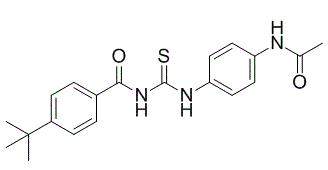| Cas No.: | 380315-80-0 |
| Chemical Name: | Benzamide, N-[[[4-(acetylamino)phenyl]amino]thioxomethyl]-4-(1,1-dimethylethyl)- |
| Synonyms: | Tenovin 1,Tenovin1 |
| SMILES: | C(NC(NC1=CC=C(NC(C)=O)C=C1)=S)(=O)C1=CC=C(C(C)(C)C)C=C1 |
| Formula: | C20H23N3O2S |
| M.Wt: | 369.48 |
| Purity: | >98% |
| Sotrage: | 2 years -20°C Powder, 2 weeks 4°C in DMSO, 6 months -80°C in DMSO |
| Description: | Tenovin-1 is an inhibitor of sirtuin 1 and sirtuin 2, an activator of p53 and may have potential in the management of cancer. |
| Target: | Sirtuin MDM-2/p53 |
| In Vivo: | Tenovin-1 (92 mg/kg, i.p.) reduces growth of tumors in SCID mice derived from BL2 cells or ARN8 cells[5]. |
| In Vitro: | Tenovin-1 (1-10 μM) induces a bell-shaped concentration-dependent cell death in SK-N-MC cells. Tenovin-1 alters the gene and protein expression of Bcl-2 family members. However, Tenovin-1 has a more powerful effect both on mRNA and protein expression levels at a lower concentration than does the higher concentration. Furthermore, Tenovin-1-induced cytotoxic effects depend on caspases in p53 wild-type WE-68 cells, but not in p53 null SK-N-MC cells. AIF plays a major role in tenovin-1-induced cell death in p53 null SK-N-MC cells, but not in p53 wild-type WE-68 cells. Reactive oxygen species are also involved in tenovin-1-mediated cell death in SK-N-MC cells. In addition, Tenovin-1 causes DNA damage in SK-N-MC cells[1]. Tenovin-1 (5 μM) increases the nuclear size in glioblastoma cells and rat primary astrocytes. Tenovin-1 induces cellular senescence, wich does not appear to be related to cell death[2]. Tenovin-1 protects p53 from mdm2-mediated degradation with little effect on p53 synthesis. Tenovin-1 targets a factor(s) upstream of p53 that not only modulates p53 function but also other cellular pathways. Tenovin-1 (10 μM) inhibits SirT2 deacetylase activity[3]. Tenovin-1 (10 μM) reduces proliferation and anchorage independent growth of NSCLC cells. Tenovin-1 also inhibits cell growth of H358 lung cancer cells[4]. |
| Cell Assay: | Cell viability is measured by thiazolyl blue tetrazolium bromide (MTT) assay. Cells are seeded in 96-well plates. When indicated they are treated with 10 μM Tenovin-1 (tnv-1) or are transfected with siRNAs. After the specified period of time, MTT solution (0.5 mg/mL) is added. The formazan crystals are dissolved in an extraction buffer (50% dimethylformamide and 20% SDS, pH 4.7). The absorbance (540/690 nm) is measured in a SunRise plate reader[4]. |
| Animal Administration: | ARN8 melanoma or BL2 Burkitt’s lymphoma cells are injected into the flank of SCID mice and allowed to develop until tumors become palpable. Tenovin-1 (in 70% cyclodextrin) is administered daily (14 days) by intraperitoneal injection at 92.5 mg/kg and tumor growth is measured over a period of 18 days. Control animals are treated with 70% cyclodextrin. In the BL2 experiment, n = 12 for each treatment. In the ARN8 experiment, n = 14 for the control group and n = 16 for the tenovin-1 treated group. Growth measurements are averaged between groups and plotted[5]. |
| References: | [1]. Marx C, et al. The sirtuin 1/2 inhibitor tenovin-1 induces a nonlinear apoptosis-inducing factor-dependent cell death in a p53 null Ewing's sarcoma cell line. Invest New Drugs. 2017 Nov 18. [2]. Yoon KB, et al. Induction of Nuclear Enlargement and Senescence by Sirtuin Inhibitors in Glioblastoma Cells. Immune Netw. 2016 Jun;16(3):183-8. [3]. Lain S, et al. Discovery, in vivo activity, and mechanism of action of a small-molecule p53 activator. Cancer Cell. 2008 May;13(5):454-63. [4]. Grbesa I, et al. Expression of sirtuin 1 and 2 is associated with poor prognosis in non-small cell lung cancer patients. PLoS One. 2015 Apr 27;10(4):e0124670. [5]. Lain S, et al. Discovery, in vivo activity, and mechanism of action of a small-molecule p53 activator. Cancer Cell. 2008 May;13(5):454-63. |

 DC Chemicals' products qualify for U.S. tariff exemptions. We guarantee no price increases due to customs duties and maintain stable supply, continuing to deliver reliable research solutions to our American clients.
DC Chemicals' products qualify for U.S. tariff exemptions. We guarantee no price increases due to customs duties and maintain stable supply, continuing to deliver reliable research solutions to our American clients.





















